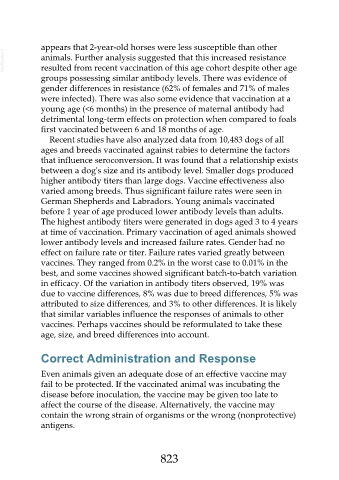Page 823 - Veterinary Immunology, 10th Edition
P. 823
appears that 2-year-old horses were less susceptible than other
VetBooks.ir animals. Further analysis suggested that this increased resistance
resulted from recent vaccination of this age cohort despite other age
groups possessing similar antibody levels. There was evidence of
gender differences in resistance (62% of females and 71% of males
were infected). There was also some evidence that vaccination at a
young age (<6 months) in the presence of maternal antibody had
detrimental long-term effects on protection when compared to foals
first vaccinated between 6 and 18 months of age.
Recent studies have also analyzed data from 10,483 dogs of all
ages and breeds vaccinated against rabies to determine the factors
that influence seroconversion. It was found that a relationship exists
between a dog's size and its antibody level. Smaller dogs produced
higher antibody titers than large dogs. Vaccine effectiveness also
varied among breeds. Thus significant failure rates were seen in
German Shepherds and Labradors. Young animals vaccinated
before 1 year of age produced lower antibody levels than adults.
The highest antibody titers were generated in dogs aged 3 to 4 years
at time of vaccination. Primary vaccination of aged animals showed
lower antibody levels and increased failure rates. Gender had no
effect on failure rate or titer. Failure rates varied greatly between
vaccines. They ranged from 0.2% in the worst case to 0.01% in the
best, and some vaccines showed significant batch-to-batch variation
in efficacy. Of the variation in antibody titers observed, 19% was
due to vaccine differences, 8% was due to breed differences, 5% was
attributed to size differences, and 3% to other differences. It is likely
that similar variables influence the responses of animals to other
vaccines. Perhaps vaccines should be reformulated to take these
age, size, and breed differences into account.
Correct Administration and Response
Even animals given an adequate dose of an effective vaccine may
fail to be protected. If the vaccinated animal was incubating the
disease before inoculation, the vaccine may be given too late to
affect the course of the disease. Alternatively, the vaccine may
contain the wrong strain of organisms or the wrong (nonprotective)
antigens.
823

